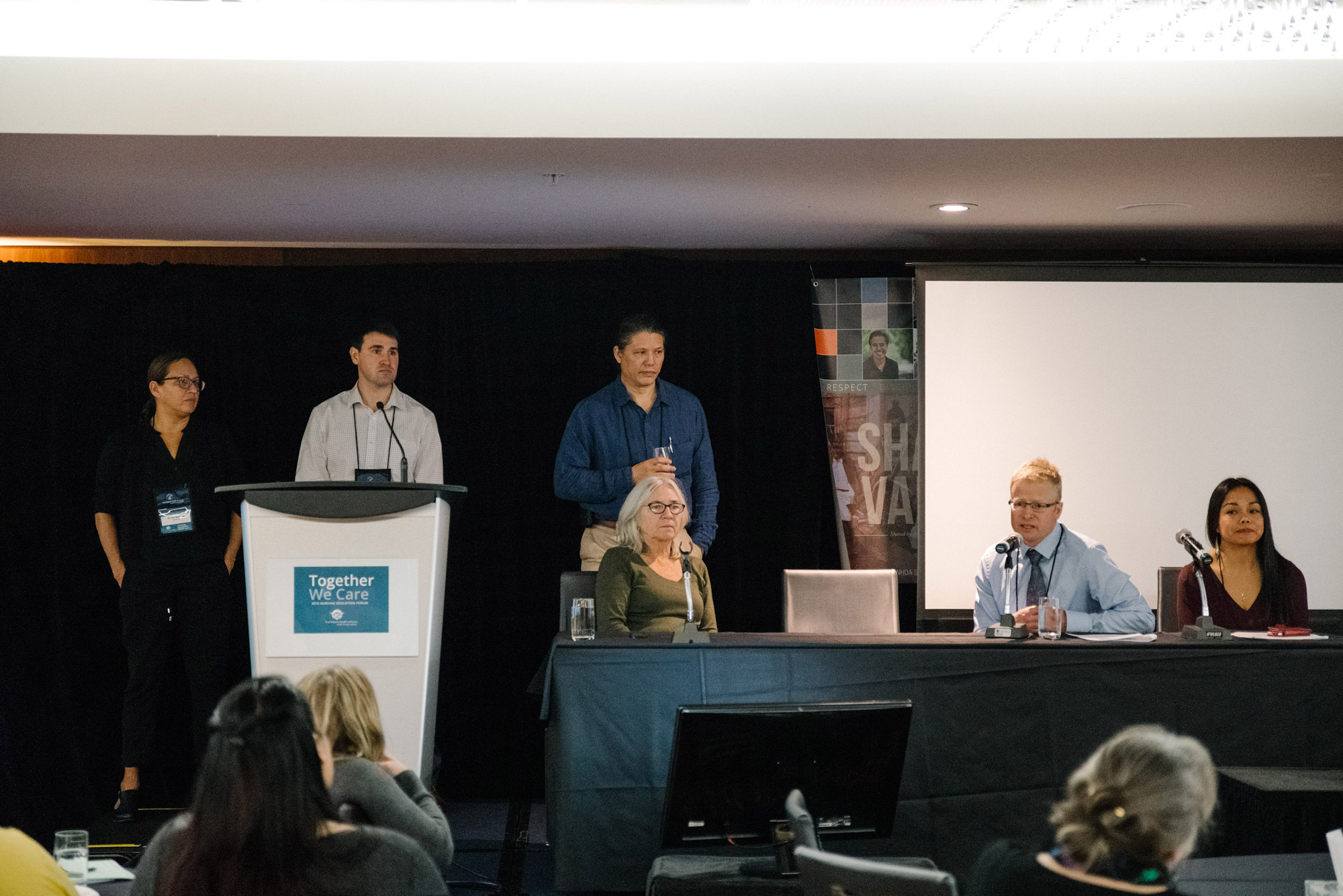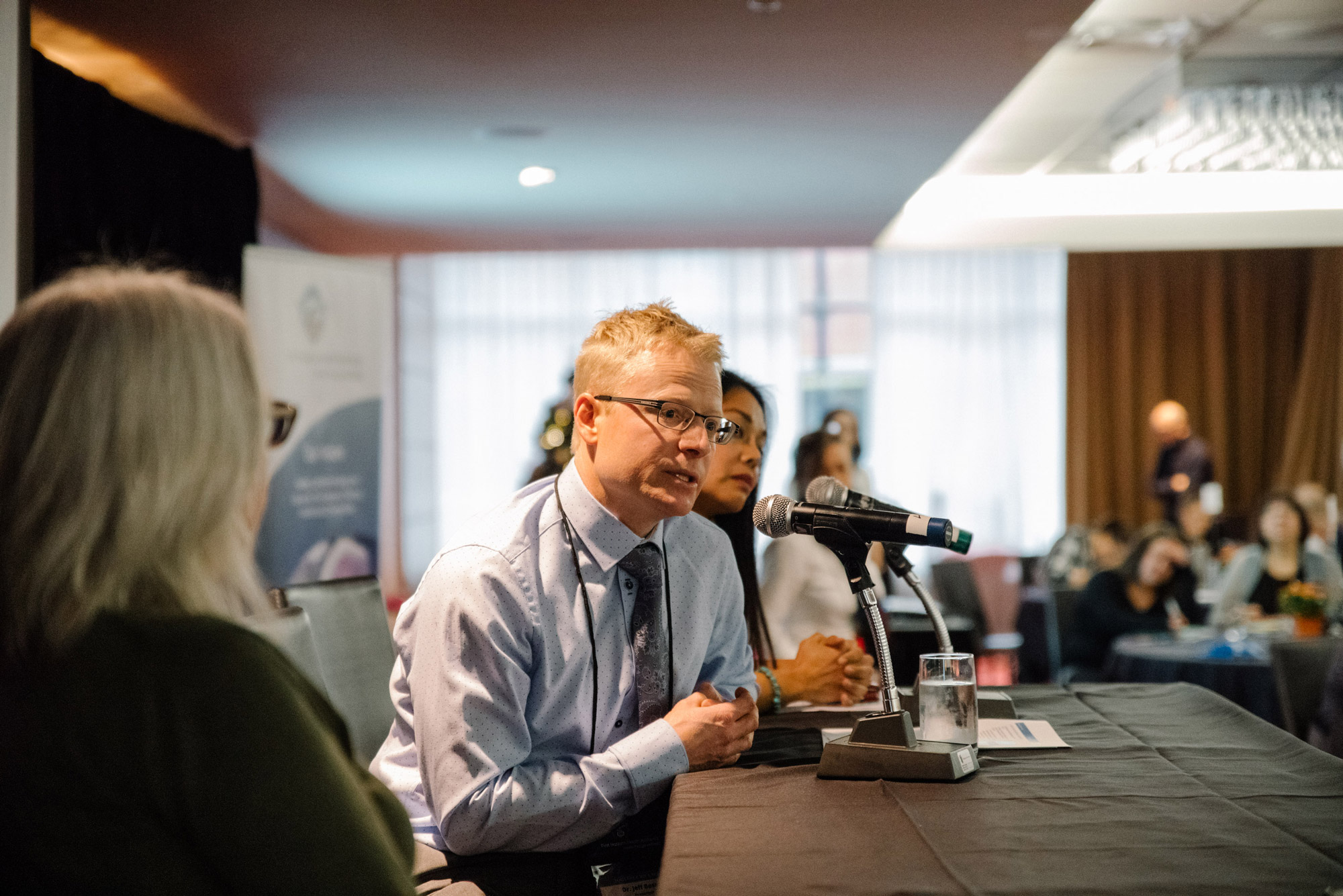FNHA Nursing Education Forum Panel Discussion on Substance Use and Mental Health

For B.C. doctor Jeff Beselt, the experience of two female patients encapsulates the tragedy and the triumph of coping with opioid addiction. Both women were discharged from a detox program on the same Friday in 2016. On the following Sunday, one of the women passed away as a result of an opioid overdose poisoning. The second woman is now pregnant and due to deliver her baby any day now, having been prescribed Suboxone that helped her successfully cope with her addiction.
“She recently told me that she and her husband have already bought Christmas presents for the kids,” he told delegates at the FNHA Nursing Education Forums held in November. “She said their family hasn’t celebrated Christmas for years because [when they were addicted,] she and her husband were only thinking about whether they’d have enough pills to get through the season.”
These stories were shared with the permission of the people or families involved, who want to support others and prevent further tragedy. “We are learning from these terrible losses and adapting our approaches so we can offer new ways to help people deal with substance addiction.”
Dr. Beselt’s comments came during a panel discussion on mental health and substance use. The panelists were (in alphabetical order by last name):
• Dr. Jeff Beselt, Community Physician, Kwadacha and Tsay Keh Dene Nations; and Emergency Physician, Campbell River
• Leah Diana, RNc, BSN; Nurse in Charge, Tsay Keh Dene and other nursing stations
• Ben Rolph; Policy Analyst, FNHA and member of the FNHA Cannabis Working Group
• Dr. Sean Wachtel, Medical Officer, Health Services and Population Health, FNHA
• Dr. Nel Wieman, Senior Medical Officer, Mental Health and Wellness, FNHA
• Cathy Zarchynski, RN, Practice Consultant for Substance Use, FNHA

Opioid Agonist Therapy - OAT
Many of the panelists spoke about the value of using Suboxone (the trade name for buprenorphine) in opioid agonist therapy (commonly called OAT). Buprenorphine and Methadose (Methadone) are long-acting opioid medications that are used to replace the shorter-acting opioids a person is addicted to, such as heroin, oxycodone, hydromorphone (Dilaudid), fentanyl and Percocet. By acting slowly, these opioid agonists prevent withdrawal for 24 to 36 hours without causing a person to feel intoxicated (“high”).
Suboxone is newer than methadone and is the first line treatment for Opioid Use Disorder (OUD) as it is considered the safest and most effective medication to treat for opioid use.
“Suboxone has a medicinal effect that prevents withdrawal symptoms but does not produce a ‘high’,” explained Cathy Zarchynski. “It helps people feel normal again, as opposed to methadone.”
She noted that there is increased access to Suboxone at all of the eight FNHA Nursing stations as Suboxone has been added to the benefits formulary.
There is a challenge, however, in getting doctors to prescribe Suboxone despite it being “truly the difference between life and death,” as Dr. Beselt said. In his 15 years as a doctor he said opioid agonist therapy “has been the most rewarding part of treatment that I’ve been involved with.”
Nonetheless, Suboxone is only available in relatively few areas throughout the province.
“Why aren’t [doctors/NPs] prescribing this safe, life-saving treatment?” Cathy Zarchynski asked. “As nurses we can ask these questions.”
She also noted that nurses can support OAT treatment, starting by taking the free, online course offered through the BC Centre on Substance Use.
Dr. Sean Wachtel reported that the FNHA is preparing a list of doctors who will prescribe Suboxone and who can work with communities where no prescribers are available. Cathy Zarchynski said telehealth is one way to connect people with a prescriber. She also noted that other elements are necessary in order for a community to offer OAT treatment:
• Request for support from clients or community
• Pharmacy that can dispense and provide the medication
• Safe storage and handling
• Availability of counselling services
Counselling is crucial, she said, because “when you take away that [addictive] substance, trauma comes up and you need to be prepared to deal with it.”
Dr. Beselt said addiction treatment takes a long time “and you have to do it well.” Going on Suboxone – or Methadose for that matter – is one thing. Coming off it is also challenging and slow. Dr. Beselt said for all aspects of treatment it’s important for patients to have a relationship of trust with their health care providers, which is where community nurses can play an important role. “You have these relationships – use them.”
Leah Diana said traditional Indigenous practices can help people cope with the physical and mental challenges of substance withdrawal, for example, “a family might surround a person [going through withdrawal], using culture, prayer and love to create a safe, non-stigmatizing, compassionate space.”

Getting to the Root of Addiction
Dr. Nel Wieman said it’s important for health care providers to understand why people use any addictive substances in the first place.
“The reasons may be social or medical – sometimes self-prescribed – but they are always because people want to change how they feel,” she said. While some people are started on narcotics by their doctors after an injury such as a broken leg, Dr. Wieman noted that many people who consume addictive substances are doing so to cope with mental health issues.
“They may feel depressed all the time and anxious all the time. Complex trauma is a very uncomfortable way to exist in the world and it’s important that we take some time in a clinical situation to understand what’s going on with a person. Treatment of mental health issues goes hand-in-hand with treating substance use.”
Health Risks of Cannabis Use
Dr. Wieman’s presentation included a description of the health risks associated with the use of the psychoactive form of cannabis (i.e., cannabis with a predominance of the substance THC).
“We are particularly concerned about youth under age 25 using regularly because the brain is more vulnerable to injury while it is developing,” she said.
Risks can include a negative impact on motivation, IQ, educational attainment, and the lung problems associated with smoking. There is also a risk of addiction and cannabis-induced psychosis that can last up to 30 days in some people and trigger the onset of psychotic illness in a subset of these.
“There is some evidence that a history of trauma makes people more susceptible [to the risks of cannabis use],” she said, “and this is particularly important in our population.”
Cannabis also crosses the placenta and is found in breastmilk. Its use is not recommended for pregnant women due to the possible risk of pre-term labour and long-term consequences for babies, which could include increased learning challenges, hyperactivity, and impulse disorders.
“While these risks may also be related to family dynamics and other social determinants of health, we ask pregnant women to avoid or at least reduce their medical or non-medical use of cannabis and only use via a vapourizer,” Dr. Wieman said.
The FNHA embraces a harm reduction approach to cannabis and has created a new web portal to explore cannabis use options at
www.fnha.ca/cannabisOther Resources Available on Substance UseThe First Nations Health Authority (FNHA) will respond to community requests to speak about cannabis topics. Contact Benjamin Rolph at
604-699-3174 or email
Benjamin.rolph@fnha.caThe
BC Centre on Substance Use, conducts research, develops clinical practice guidelines, and offers resources and training, including an online course – the
Provincial Opioid Addiction Treatment Support Program – that is required for opioid agonist treatment prescribers but is available free to all health care providers or anyone else with an interest in this therapy.

